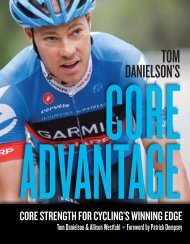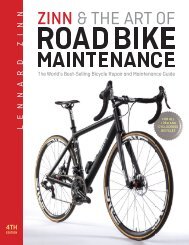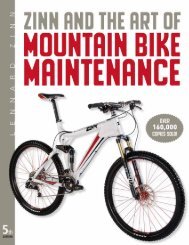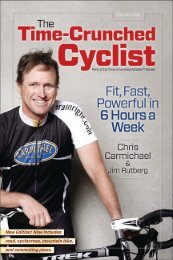a preview of The Runner's Guide to Yoga - VeloPress
a preview of The Runner's Guide to Yoga - VeloPress
a preview of The Runner's Guide to Yoga - VeloPress
Create successful ePaper yourself
Turn your PDF publications into a flip-book with our unique Google optimized e-Paper software.
imbalances lie. Many yoga poses naturally create balance by strengthening one part <strong>of</strong><br />
the body and stretching another. A lunge, for example, strengthens the front leg while<br />
stretching the back leg. At the same time, a lunge requires balance between the inner<br />
and outer thighs, the front and back <strong>of</strong> the <strong>to</strong>rso, and the upper and lower body. Some<br />
poses focus more on strength, others target flexibility, and still others balance strength<br />
and flexibility by focusing fully on rest.<br />
<strong>Yoga</strong> will help you balance strength and flexibility by increasing both and teaching<br />
you which types <strong>of</strong> exercises will best balance your needs. By cultivating balance,<br />
you’ll be able <strong>to</strong> run more mileage, faster, with less physical and mental effort. This<br />
balance is the focus <strong>of</strong> Chapter 2.<br />
Sample pages from <strong>The</strong> <strong>Runner's</strong> <strong>Guide</strong> <strong>to</strong> <strong>Yoga</strong> by Sage Rountree<br />
Copyright 2012 <strong>VeloPress</strong> All rights reserved<br />
THE RUNNER’S GUIDE TO YOGA | 7














